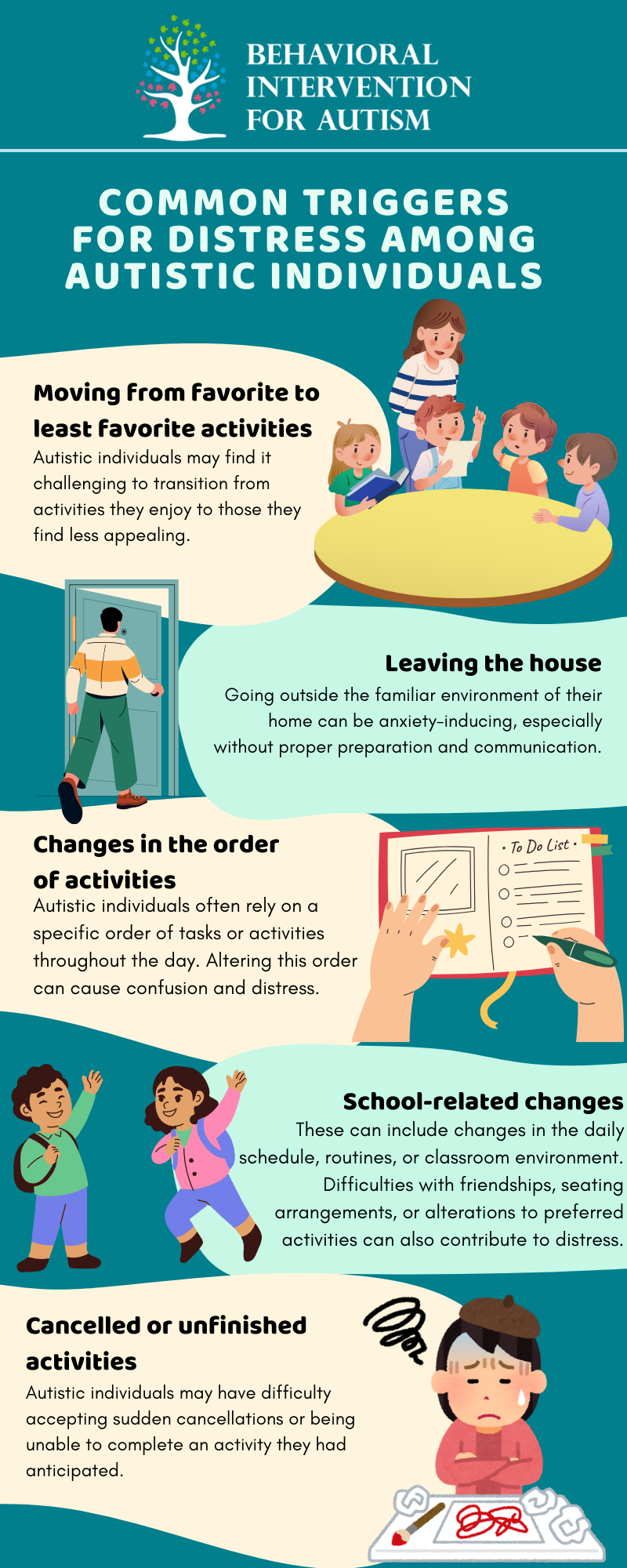
Table of Contents
Autism is a neurodevelopmental disorder that affects individuals in various ways, including their ability to handle changes in routine. Sudden changes can have a significant impact on autistic individuals, often leading to distress and difficulty adapting.
Understanding the impact of these changes and identifying common triggers for distress can help parents, caregivers, and individuals with autism develop effective coping strategies.
Impact of Sudden Changes on Autistic Individuals
Autistic individuals heavily rely on structure and predictability in their daily lives. Sudden changes can disrupt their sense of security and familiarity, leading to a range of challenging behaviors. Some common responses to sudden changes may include isolation, aggressive behaviors, repeated behaviors, or tantrums.
These reactions are a result of the individual’s struggle to adapt to the unexpected and their preference for knowing what to expect during the day.
Common Triggers for Distress
Various situations and events can trigger distress in autistic individuals when it comes to changes in routine. Some of the common triggers include:
It is important to note that while autistic individuals may initially struggle with changes to routines, they can improve their ability to handle these changes with time and support.
Visual strategies, such as visual schedules, are often more effective than verbal explanations in helping individuals understand and cope with routine changes. By providing structure, predictability, and clear communication, caregivers and parents can help autistic individuals navigate changes in routine more effectively.
Strategies for Managing Routine Changes
There are several strategies that can be implemented to help ease the transition and reduce distress. Let’s look at each of them.
Advance Notice and Communication
One of the most effective strategies for helping autistic individuals cope with routine changes is providing advance notice and clear communication.
Letting the individual know in advance about potential changes allows them time to mentally prepare and adjust their expectations. This can be especially helpful for individuals who thrive on predictability and find sudden changes overwhelming.
By communicating the upcoming changes in a clear and concise manner, using visual aids if necessary, you can help the individual understand what to expect and provide them with a sense of control.
Building a warning system for unexpected changes, such as using a “mystery” symbol like a question mark in visual schedules, can also assist in preparing autistic individuals for sudden changes.
Visual Schedules and Predictability
Using visual aids such as pictorial schedules, timers, or countdowns can be immensely beneficial. Timers, for example, can help individuals who struggle with transitioning between activities by providing a visual countdown, allowing them to better comprehend when an activity will end or when it’s time to move on to the next task.
Visual supports can also include photos or symbols representing new places, people, or activities. These visual cues help individuals with autism better comprehend and process the changes that lie ahead, reducing anxiety and facilitating a smoother transition.
Calming Techniques for Unexpected Changes
Even with careful planning, unexpected changes can still occur. It is important to equip autistic individuals with coping strategies to navigate these situations.
Some calming techniques that can be helpful include:
- Encouraging the individual to think of possible best and worst-case scenarios to prepare for various outcomes.
- Practicing breathing exercises or meditation techniques that can be used when feeling distressed or overwhelmed.
- Encouraging the individual to consider alternative activities or plans that may be just as enjoyable or even better than the original plan.
Implementing these strategies for managing routine changes can significantly enhance the ability of individuals with autism to adapt and cope with transitions.
Supporting Autistic Children with Routine Changes
As for kids, there are different strategies that can be implemented. These are as follows:
Transition Preparation and Visual Aids
Preparing autistic children for transitions and changes in daily routines can significantly help them understand what to expect and cope better with change.
This can be done through various strategies, including:
- Social stories – These are short narratives that provide information about a specific situation or event, helping children understand the sequence of events and the expected behavior during the transition.
- Timetables and visual schedules – These visual aids can be used to outline the daily routine and highlight any upcoming changes or transitions. Autistic children can refer to these schedules to understand what activities will occur and when they will take place.
- Extra time for discussion – Allowing autistic children the opportunity to discuss upcoming changes or transitions can help alleviate anxiety and provide a sense of control. This can include answering questions, addressing concerns, and providing reassurance.
- Timers – Timers can be useful tools for autistic children who find it challenging to switch between activities. By providing a visual countdown, timers help the child understand when an activity will end or when it’s time to move on to the next task.
- Warning system for unexpected changes – Creating a warning system for unexpected changes can help autistic children prepare for sudden alterations in their routines. By using a ‘mystery’ symbol, such as a question mark, in visual schedules, children can gradually learn to cope with unexpected events and adjust to changes more effectively.
Gradual Introductions to New Activities
Introducing just one change at a time and gradually adding new activities can help autistic children process change at a comfortable pace. This method allows children to become accustomed to new activities before introducing more challenging transitions.
By providing a structured and step-by-step approach, caregivers can support autistic children in adapting to new routines without overwhelming them.
Building Resilience to Unexpected Events
Autistic individuals often prefer to have a daily routine to know what will happen each day. They may find it challenging to deviate from their established routines once they have learned the “right” way to do something. Unexpected changes, in particular, can be difficult for them to navigate.
However, building resilience to unexpected events can help autistic children cope with such situations more effectively. This can be achieved by gradually exposing them to small variations in their routines and providing support and reassurance when unexpected changes occur.
Over time, they can develop coping mechanisms and learn to adapt to alterations in their routines.
By implementing these strategies, caregivers can provide valuable support to autistic children as they navigate routine changes. Remember, each child is unique, so it’s important to tailor these approaches to meet their individual needs and preferences. Reach out today to see how our high-quality ABA therapy in Florida can help you. Get in touch to learn more and start making a positive impact on your child’s development.
Sources:
https://raisingchildren.net.au/autism/behaviour/understanding-behaviour/changing-routines-asd
https://autismawarenesscentre.com/coping-with-changes-in-routines
https://www.autism.org.uk/advice-and-guidance/topics/behaviour/dealing-with-change/all-audiences
https://www.asdtoday.com/post/autism-sudden-changes-and-how-to-manage-them
- 9 Common Obsessions of Children With Autism You Should Know - February 25, 2025
- What is Neurodiversity? A Guide to Embracing Differences - February 25, 2025
- Understanding Hyperfocus in Autism: What It Means and Why It Happens - February 25, 2025




